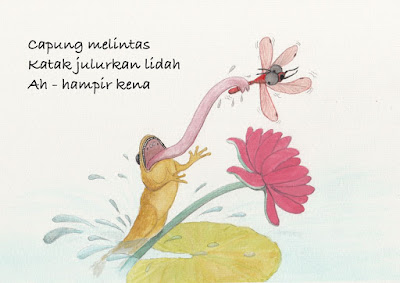What is Haiku?
It is a short poetry (tend to be about nature), consist of 17 syllables (5 syllables for first line, 7 for second line, and 5 for the last line). It has a "kigo" (seasonal reference) and "kireji". Kireji it self has no English translation. This explanation about "kireji" is taken from Wikipedia :
There is no exact equivalent of kireji in English, and its function can be difficult to define. It is said to supply structural support to the verse.[1] When placed at the end of a verse, it provides a dignified ending, concluding the verse with a heightened sense of closure. Used in the middle of a verse, it briefly cuts the stream of thought, indicating that the verse consists of two thoughts half independent of each other.[2] In such a position, it indicates a pause, both rhythmically and grammatically, and may lend an emotional flavour to the phrase preceding it.
For me, writing a haiku means doing a meditative writing. I often inspired by my own painting/art creation, and make this painting /art creation as my "Haiga" (illustrated Haiku).
This is my first Haiku and Haiga (written in my mother tongue, Bahasa Indonesia, edited from the original from my friend's feedback):
If it's translated into English, the amount of the syllables will be different. The picture is taken from my picture book "Dragonfly and Damselfly". Here is my free translation of it (with my limited English, of course :D ) :
a dragonfly passes
the frog sticks out his tongue
oops - it's almost caught
Now, about Senryuu. Senryuu is a Haiku without "kigo" and "kireji", often cynical or darkly humorous (while Haiku are more serious).Here is my first Senryuu:
Here is my free translation:
the witch
rides on her broom
without her helmet
I collect my haiku and senryuu in one album, here, while share them in a group of Haiku lovers, New Haiku.


No comments:
Post a Comment